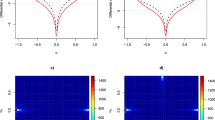Abstract
Jeffrey’s divergence (JD), the symmetric Kullback-Leibler (KL) divergence, has been used in a wide range of applications. In recent works, it was shown that the JD between probability density functions of k successive samples of autoregressive (AR) and/or moving average (MA) processes can tend to a stationary regime when the number k of variates increases. The asymptotic JD increment, which is the difference between two JDs computed for k and \(k-1\) successive variates tending to a finite constant value when k increases, can hence be useful to compare the random processes. However, interpreting the value of the asymptotic JD increment is not an easy task as it depends on too many parameters, i.e. the AR/MA parameters and the driving-process variances. In this paper, we propose to compute the asymptotic JD increment between the processes that have been normalized so that their powers are equal to 1. Analyzing the resulting JD on the one hand and the ratio between the original signal powers on the other hand makes the interpretation easier. Examples are provided to illustrate the relevance of this way to operate with the JD.
Access this chapter
Tax calculation will be finalised at checkout
Purchases are for personal use only
Similar content being viewed by others
References
Assaleh, K., Al-Nashash, H., Thakor, N.: Spectral subtraction and cepstral distance for enhancing EEG entropy. In: IEEE Proceedings of the Engineering in Medicine and Biology, vol. 3, pp. 2751–2754 (2005)
Bobillet, W., Diversi, R., Grivel, E., Guidorzi, R., Najim, M., Soverini, U.: Speech enhancement combining optimal smoothing and errors-in-variables identification of noisy AR processes. IEEE Trans. Signal Proces. 55, 5564–5578 (2007)
Abou-Moustafa, K., Ferrie, F.P.: A note on metric properties for some divergence measures: the Gaussian case. JMLR Workshop and Conference Proceedings, vol. 25, pp. 1–15 (2012)
Formont, P., Ovarlez, J., Pascal, F., Vasile, G.: On the extension of the product model in POLSAR processing for unsupervised classification using information geometry of covariance matrices. In: IEEE International Geoscience and Remote Sensing Symposium, pp. 1361–1364 (2011)
Murthy, R., Pavlidis, I., Tsiamyrtzis, P.: Touchless monitoring of breathing function. In: IEEE EMBS, pp. 1196–1199 (2004)
Magnant, C., Giremus, A., Grivel, E.: On computing Jeffrey’s divergence between time-varying autoregressive models. IEEE Signal Process. Lett. 22(7), 915–919 (2014)
Magnant, C., Giremus, A., Grivel, E.: Jeffreys divergence between state models: application to target tracking using multiple models. In: EUSIPCO, pp. 1–5 (2013)
Yueh, W.-C.: Explicit inverses of several tridiagonal matrices. Appl. Mathe. E-Notes, 74–83 (2006)
Legrand, L., Grivel, E.: Jeffrey’s divergence between moving-average and autoregressive models. IEEE ICASSP (2017)
Cernuschi-Frias, B.: A derivation of the gohberg-semencul relation [signal analysis]. IEEE Trans. Signal Proces. 39(1), 190–192 (1991)
Rao, C.: Information and the accuracy attainable in the estimation of statistical parameters. Bull. Calcutta Math. Soc. 37, 81–89 (1945)
Kullback, S., Leibler, R.A.: On information and sufficiency. Ann. Math. Stat. 22(1), 79–86 (1951)
Rasmussen, C.E., Williams, C.K.I.: Gaussian Processes for Machine Learning. MIT Press, Cambridge (2006)
Author information
Authors and Affiliations
Corresponding author
Editor information
Editors and Affiliations
Rights and permissions
Copyright information
© 2017 Springer International Publishing AG
About this paper
Cite this paper
Grivel, E., Legrand, L. (2017). Process Comparison Combining Signal Power Ratio and Jeffrey’s Divergence Between Unit-Power Signals. In: Nielsen, F., Barbaresco, F. (eds) Geometric Science of Information. GSI 2017. Lecture Notes in Computer Science(), vol 10589. Springer, Cham. https://doi.org/10.1007/978-3-319-68445-1_62
Download citation
DOI: https://doi.org/10.1007/978-3-319-68445-1_62
Published:
Publisher Name: Springer, Cham
Print ISBN: 978-3-319-68444-4
Online ISBN: 978-3-319-68445-1
eBook Packages: Computer ScienceComputer Science (R0)



